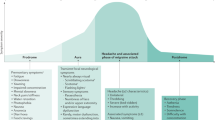Abstract
Introduction
The empirical use of oral acetylsalicylic acid (ASA) in the treatment of acute migraine attacks has led to the recommendation of ASA as a basic treatment of migraine. However, there are no controlled studies on the intravenous use of acetylsalicylic acid.
Methods
Forty patients with a 1- to 12-year history of migraine were included in this placebo-controlled trial. The sociodemographic data of patients receiving placebo or 500 mg ASA i.v. and migraine symptoms before treatment were identically distributed. Pain relief during attacks was documented by the Visual Analogue Scale (VAS) for 1 h at 5-min intervals. Furthermore, the change of concurrent non-pain symptoms was evaluated by self-rating (worse-unchanged-better-absent).
Results
The VAS showed a mean pain reduction of about 60% after 1 h versus placebo. Efficacy varied significantly between patients. We observed a small number of socalled non-responders as well as patients with complete pain relief. The most common concomitant symptoms were nausea, photophobia, vertigo, vomiting and sweating. During the time of observation these symptoms were significantly reduced compared to placebo. The study shows a maximum placebo effect of about 17% (mean value). Significant differences in pain ratings were measured 25–30 min after application (P=0.0008).
Conclusions
In this study i.v. ASA showed a significant reduction in pain intensity during migraine attacks. In addition, most concomitant non-pain symptoms were equally reduced. The onset of pain relief did not correspond with the inhibition of platelet aggregation (after 2–4 min) or with peak plasma concentrations of ASA (immediately after application) or salicylic acid (after 2–3 h). More efficacy studies with higher doses and longer periods of observation are necessary to optimize the treatment of migraine attacks with intravenous ASA. Studies including neurophysiological and vascular parameters are recommended to confirm the results of this study.
Zusammenfassung
In einer plazebokontrollierten Doppelblindstudie wurde die Wirksamkeit von 500 mg intravenös applizierter Acetylsalicylsäure (ASS) an 40 Patienten mit Migräne mit oder ohne Aura untersucht, deren soziodemographische und krankheitsbezogene Daten sich nicht wesentlich unterschieden. Die Reduktion der Schmerzintensität wurde in 5-min-Abständen auf einer visuellen Analogskala erfaßt. Nicht schmerzbezogene Symptome wurden durch eine Selbstbeurteilungsskala erhoben (schlechter-unverändert-besser-fehlend).
Bei Gabe von i.v. ASS (Aspisol®) zeigte sich gegenüber Plazebo nach 1 h durchschnittlich eine Schmerzreduktion um 60%. Der maximale Plazeboeffekt lag bei 17%. Auch die Begleitsymptomatik der Migräne wurde unter i.v. ASS signifikant gemildert. Signifikante Unterschiede zwischen Verum und Plazebo ergaben sich ab der 30. min (p=0,0008). Der Wirkungseintritt von i.v. ASS korreliert weder mit den maximalen Plasmaspiegeln von ASS oder Salicylsäure noch mit dem Beginn der Hemmung der Plättchenaggregation (nach ca. 2–4 min). Die Bedeutung dieser Daten für das Verständnis des Wirkungsprinzips der Acetylsalicylsäure bei der Therapie der Migräne sowie der Bedarf weiterer Studien zur Optimierung der Wirkung von ASS in der Behandlung der akuten Migräneattacke wird diskutiert.
Similar content being viewed by others
Literatur
Andersson PG, Hinge HG, Johansen O, Andersen CU, Lademann A, Götzsche PC (1989) Double blind study of naproxen vs. placebo in the treatment of acute migraine attacks. Cephalalgia 9: 29
D'Andrea G, Cananzi A, Toldo M, Corklazzo S, Ferro-Mikone F (1983) Platelet behaviour in classic migraine: Responsiveness to small doses of Aspirin. Thromb Haemostas 49:1153
Göbel H, Ensink FBM, Soyka D (1994) Aktueller Stand der medikamentösen Therapie akuter Migräneattacken. In: Ensink FBM, Soyka D (Hrsg) Migräne. Springer, Berlin Heidelberg New York, S 209
Göbel H, Ernst M, Jeschke J, Keil R, Weigle L (1992) Acetylsalicylic acid activates antinociceptive brain-stem reflex activity in headache patients and in healthy subjects, Pain 48:187
Groppetti A, Braga PC, Biella G, Parenti M, Rusconi L, Mantagazza P (1988) Effect of aspirin on serotonin and met-enkaphalin in brain: correlation with the antinociceptive activity of the drug. Neuropharmacology 27:409
Hakkarainen H, Gustafsson B, Stockmann O (1977) A comparative trial of ergotamin tartrate, acetylsalicylic acid and dextropropoxyphene compound in acute migraine attacks. Headache 18:35
Hakkarainen H, Quiding H, Stockmann O (1980) Mild analgesics as an alternative to ergotamine in migraine. A comparative trial with acetylsalicylic acid, ergotamine tartrate and a dextropropoxyphene compond. J Clin Pharmacol 20:590
Kloster R, Nestvold K, Nilmmig ST (1992) A double-blind study of Ibuprofen versus placebo in the treatment of acute migraine attacks. Cephalalgia 12: 169
Noda S, Itoh H, Immezaki H, Fukuda Y (1985) Successful treatment of migraine attacks with intravenous injection of Aspirin. J Neurol Neurosurg Psychiatry 48:1187
Ross-Lee L, Heazlewood V, Tyrer JH, Eaddie MJ (1982) Aspirin treatment of migraine attacks: plasma drug level data. Cephalalgia 2:9
Schwob G, Lassne C (1983) Treatment de la crise aigue de migraine par l'association acetylsalicylate de lysine-metoclopramide. Gaz Med Fr 90:625
Soyka D, Diener HC, Pfaffenrath V, Gerber WD, Ziegler A (1992) Therapie und Prophylaxe der Migräne. Überarbeitete Empfehlungen der Deutschen Migräne- und Kopfschmerzgesellschaft, MMW 134:145
The oral sumatriptan and Aspirin plus metoclopramide comparative study group (1992) Sumatriptan versus Aspirin plus metoclopramide in the acute treatment of migraine. Eur Neurol 32: 177
Tfelt-Hansen P, Olesen J (1980) Paracetamol (Acetaminophen) yersus acetylsalicylic acid in migraine. Eur Neurol 19:163
Tfelt-Hansen P, Olesen J (1984) Effervescent metoclopramide and Aspirin (migravess) versus effervescent Aspirin or placebo for migraine attacks, a double blind study. Cephalalgie 4:107
Tfelt-Hansen P, Olesen J (1985) Methodological aspects of drug trials in migraine. Neuroepidemiology 4:204
Vane JR (1971) Inhibition of prostaglandin synthesis as a mechanism of action for aspirin-like drugs. Nature 231: 232
Volans GN (1974) Absorption of effervescent aspirin during migraine. Br Pharmacol J 4:265
Volans GN (1978) Research review: Migraine and drug absorption. Clin Pharmacokin 3:313
Voss H von, Pütter J (1975) Humanpharmakokinetische Untersuchungen bei parenteraler Gabe des Lysinsalzes der Acetylsalicylsäure, Colfaritsymposium III der Bayer AG, S 48
Wilkinson M (1990) Treatment of the acute migraine: the British experience. Headache 30:545
Author information
Authors and Affiliations
Rights and permissions
About this article
Cite this article
Taneri, Z., Petersen-Braun, M. Therapie des akuten Migräneanfalls mit intravenös applizierter Acetylsalicylsäure. Schmerz 9, 124–129 (1995). https://doi.org/10.1007/BF02530130
Received:
Accepted:
Issue Date:
DOI: https://doi.org/10.1007/BF02530130




